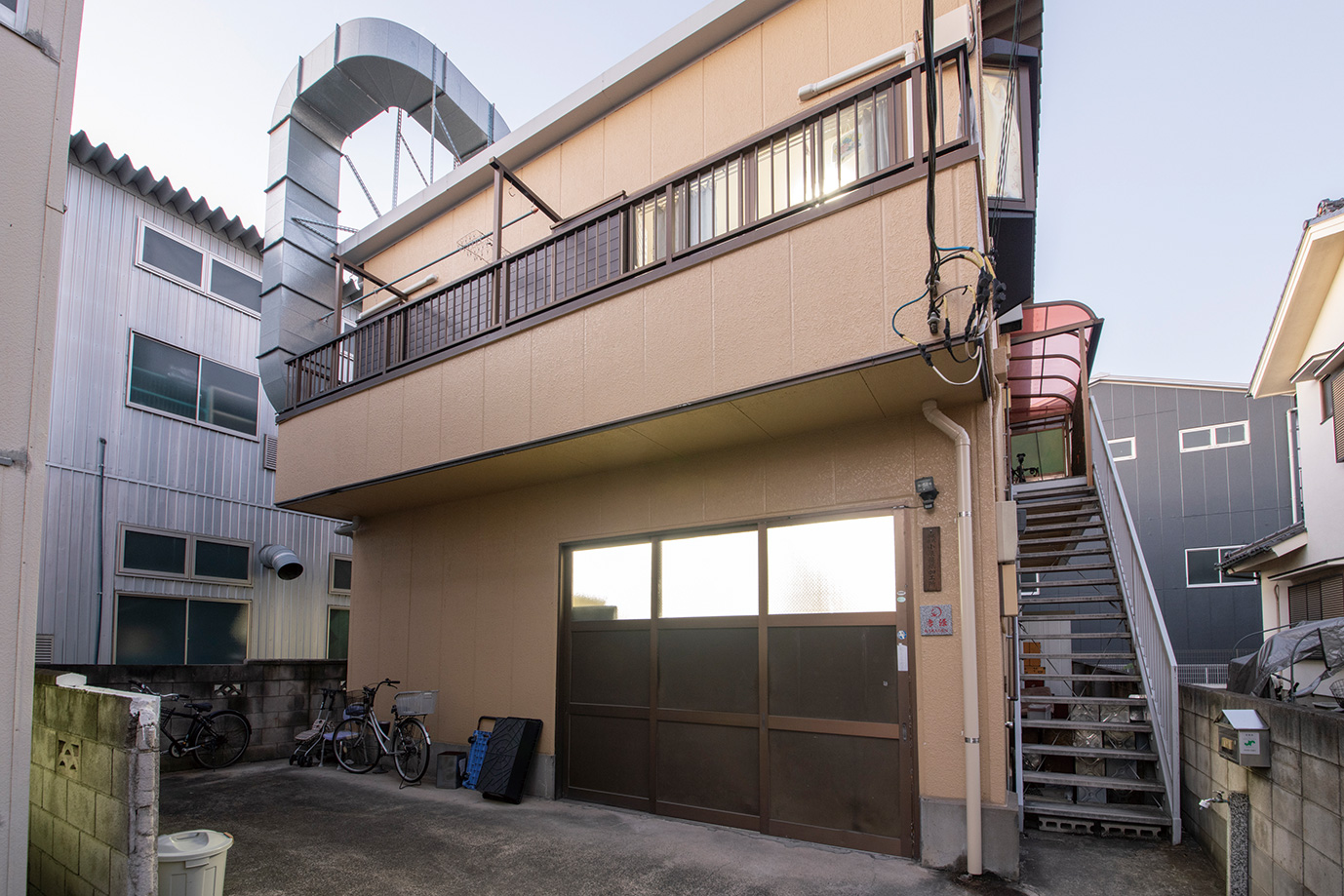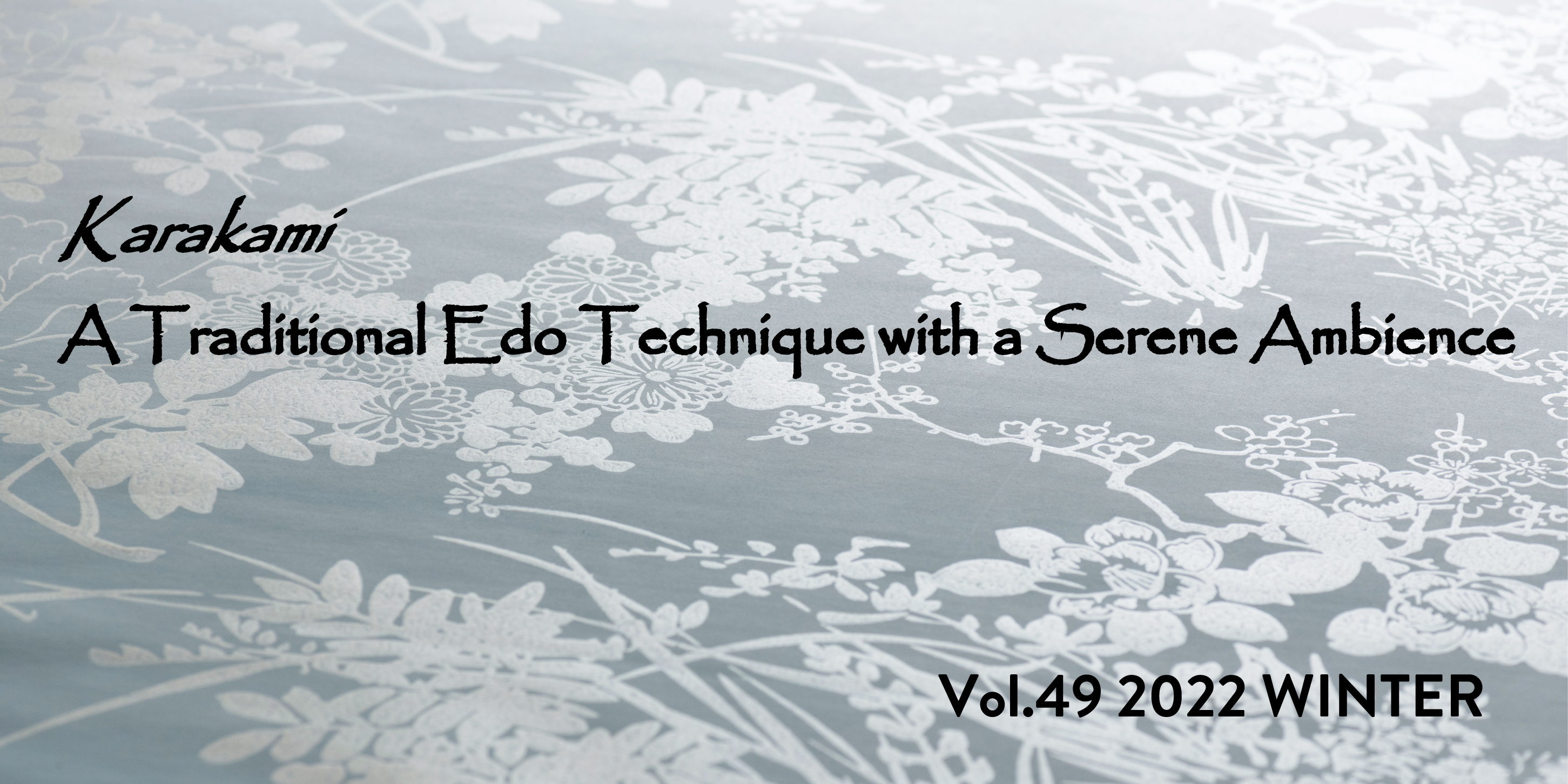
Karakami is a type of decorative paper imprinted with a rich variety of designs that is used as wallpaper and overlay in fusuma heavy sliding doors, byobu folding screens, and room partitions. Under soft light, karakami shines with a graceful shimmer and this elegant beauty creates a serene unobtrusive ambience, which has made it a beloved interior item in the living space of Japanese people since ancient times as a decorative element in Buddhist temples, teahouses, and traditional Japanese rooms. As a certified holder of Conservation Techniques for Cultural Properties, Yuki Koizumi of Karagen Inc. is Japan’s leading authority in the field of karakami making.
In his unfaltering handiwork dwells the spirit of craftsmanship dedicated to creating authentic pieces and the sense of mission to preserve for the next generations the traditional karakami techniques that date back to the Edo period.
The manual process of creating one sheet at a time is what brings out the complex beauty and unique sensibility of karakami paper.
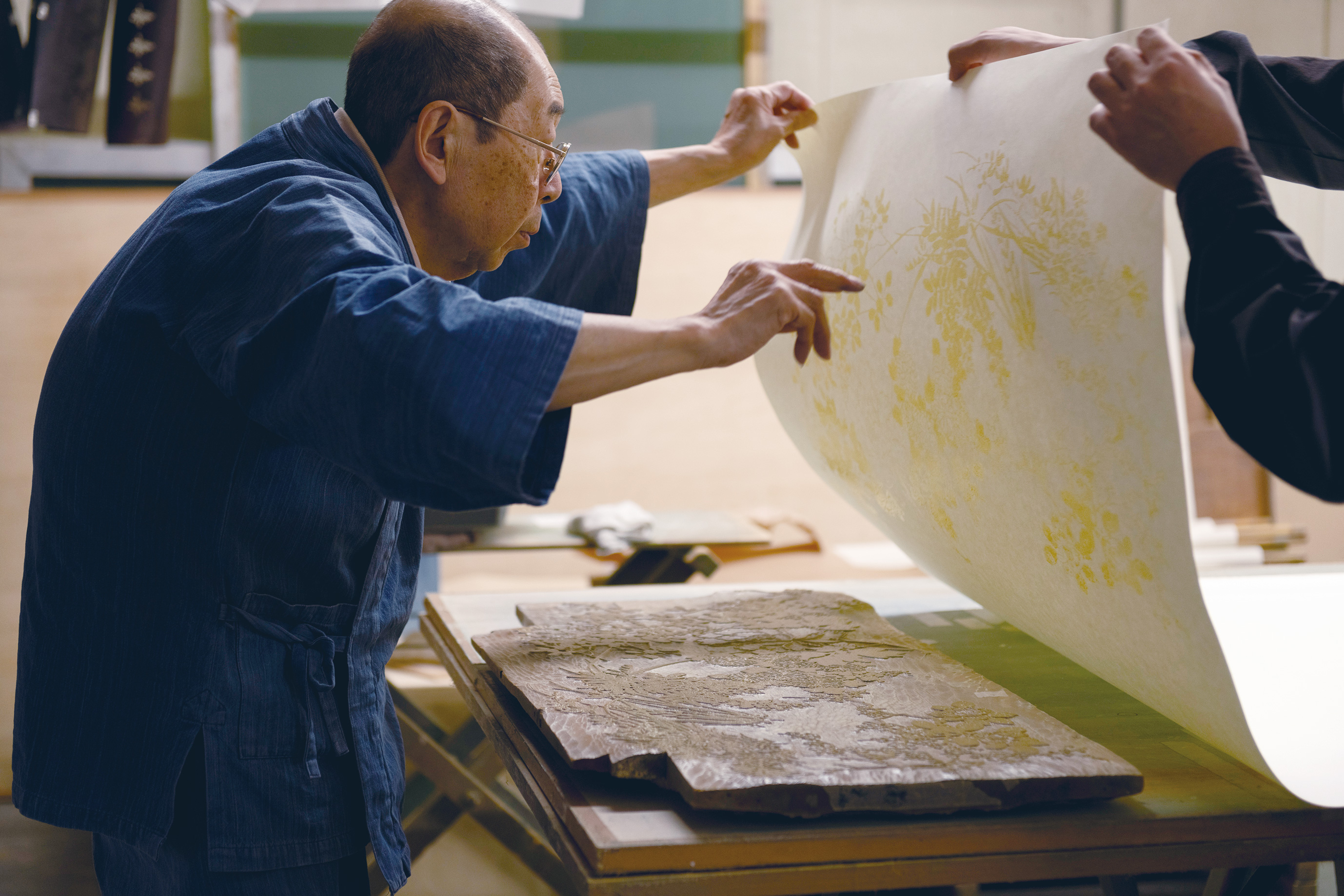
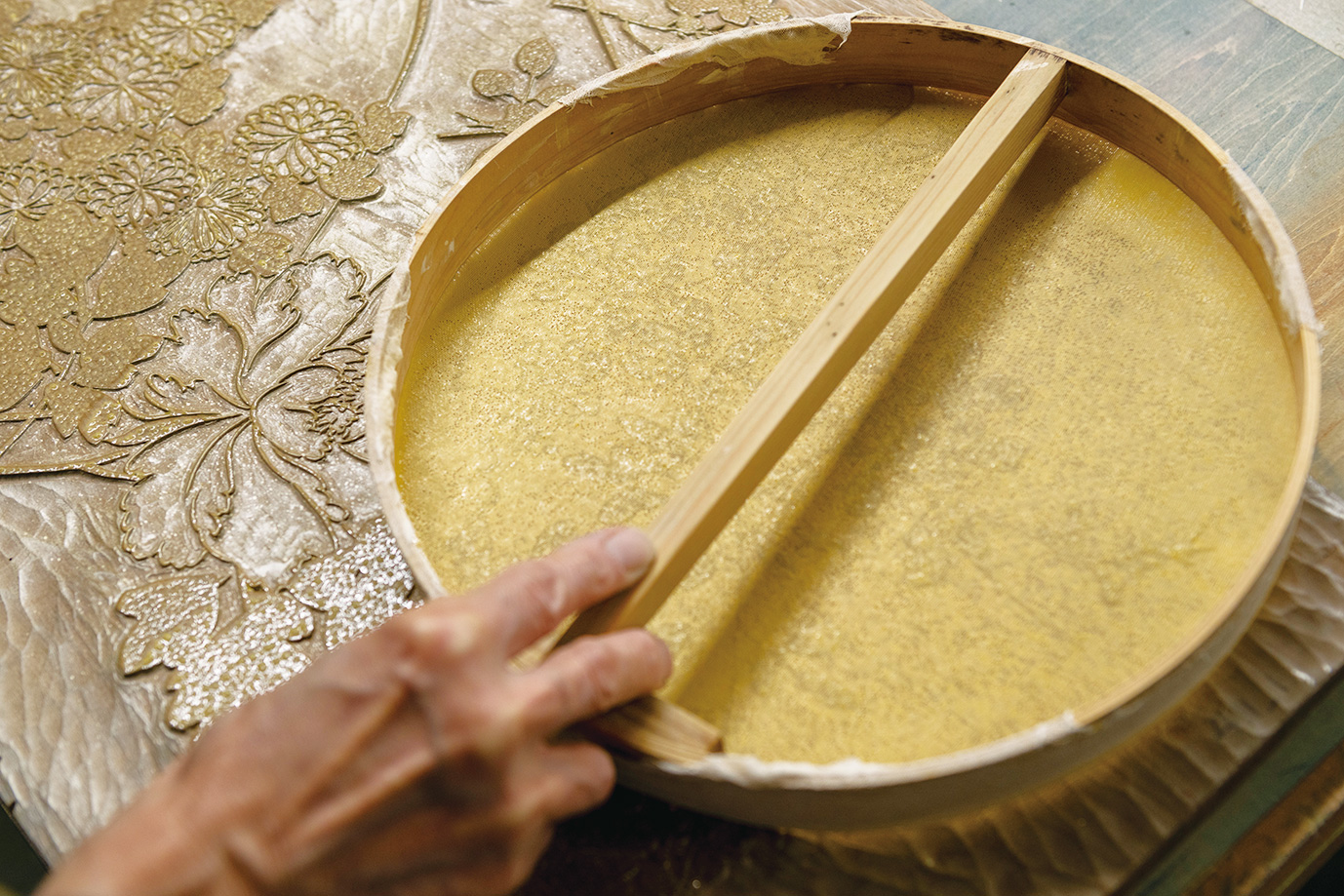
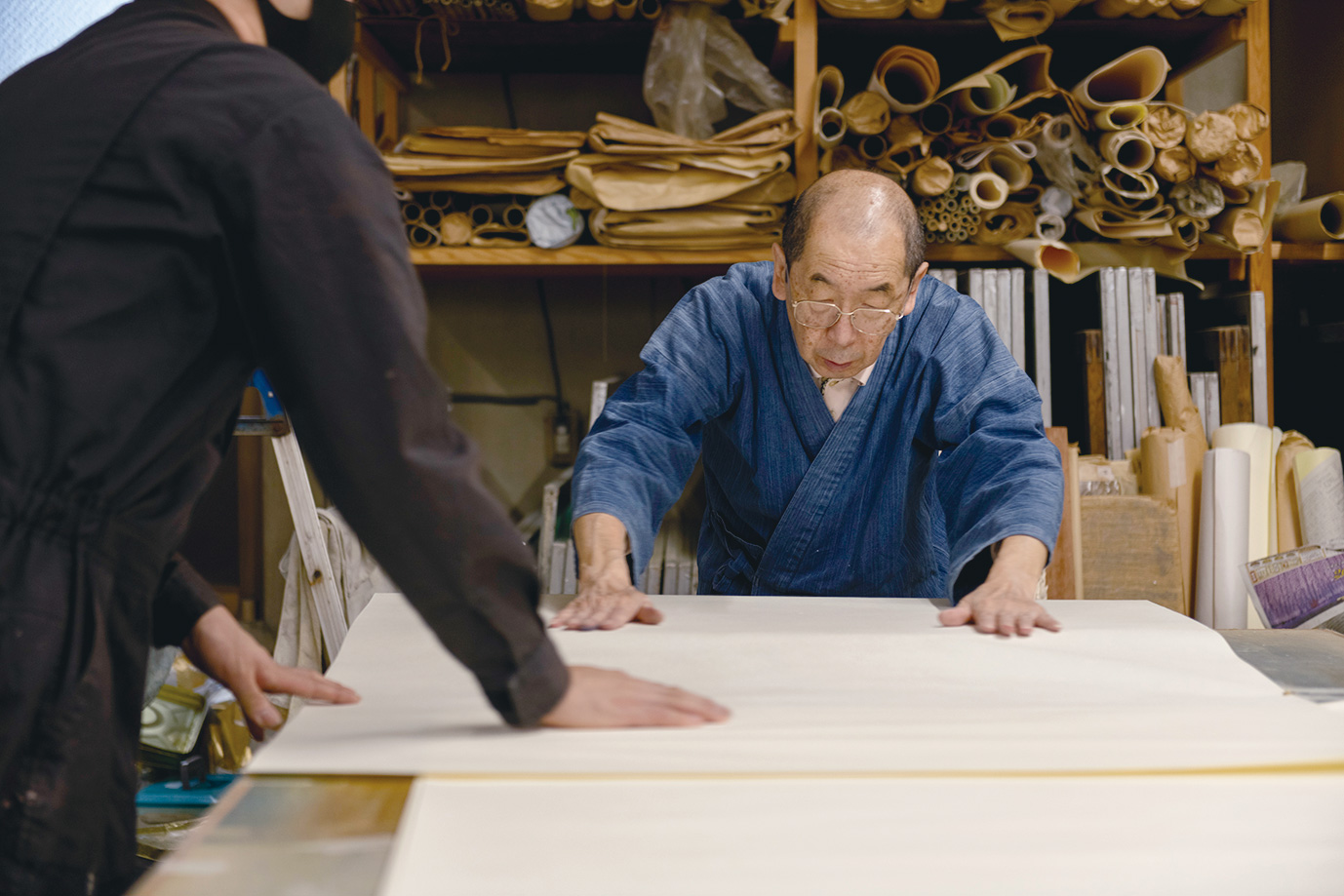
A soft whisper-like sound flows through the atelier, which is enveloped in soothing silence. The master’s hand moves smoothly, as if swimming, along the surface of the traditional Japanese washi paper sheet spread on the large worktable as he applies, without the slightest hesitation, beautiful patterns and designs to the washi. Yukio Koizumi of Karagen Inc. is Japan’s leading authority in the field of karakami making, and specifically the technique of applying pigments over the surface of woodblocks engraved by hand with traditional patterns and then transferring them to sheets of washi paper. As a descendant of Shichigoro Koizumi, the legendary karakami master of the Edo period (1603–1868) and founder of this family of craftsmen, Yukio Koizumi is the fifth generation master and third generation head of Karagen Inc., after its establishment as an independent company. Through his work, he is committed to preserving the traditional Edo craftsmanship techniques that date back to the mid-19th century.
“Compared with Kyoto karakami, Tokyo karakami is made with larger engraved woodblocks. Originally, the woodblocks were smaller, designed to fit a standard size of paper in which twelve sheets of karakami paper made up one fusuma door panel, but most of these woodblocks were destroyed in the fires of the Great Kanto Earthquake and the Great Tokyo Air Raids. Later, as it became possible to make larger sheets of washi paper, the size of Tokyo karakami was increased.” Yukio Koizumi’s father, Satoshi Koizumi, restored, through painstaking manual work, woodblocks from the Edo period, using as samples woodblocks and fusuma door panels that escaped the flames. The expansive, cascadingdesigns, which feature diverse motifs, such as flowers and herbs, waves, and clouds, incorporate the aesthetics of the Edo townsmen culture and its infatuation with chic and elegance.
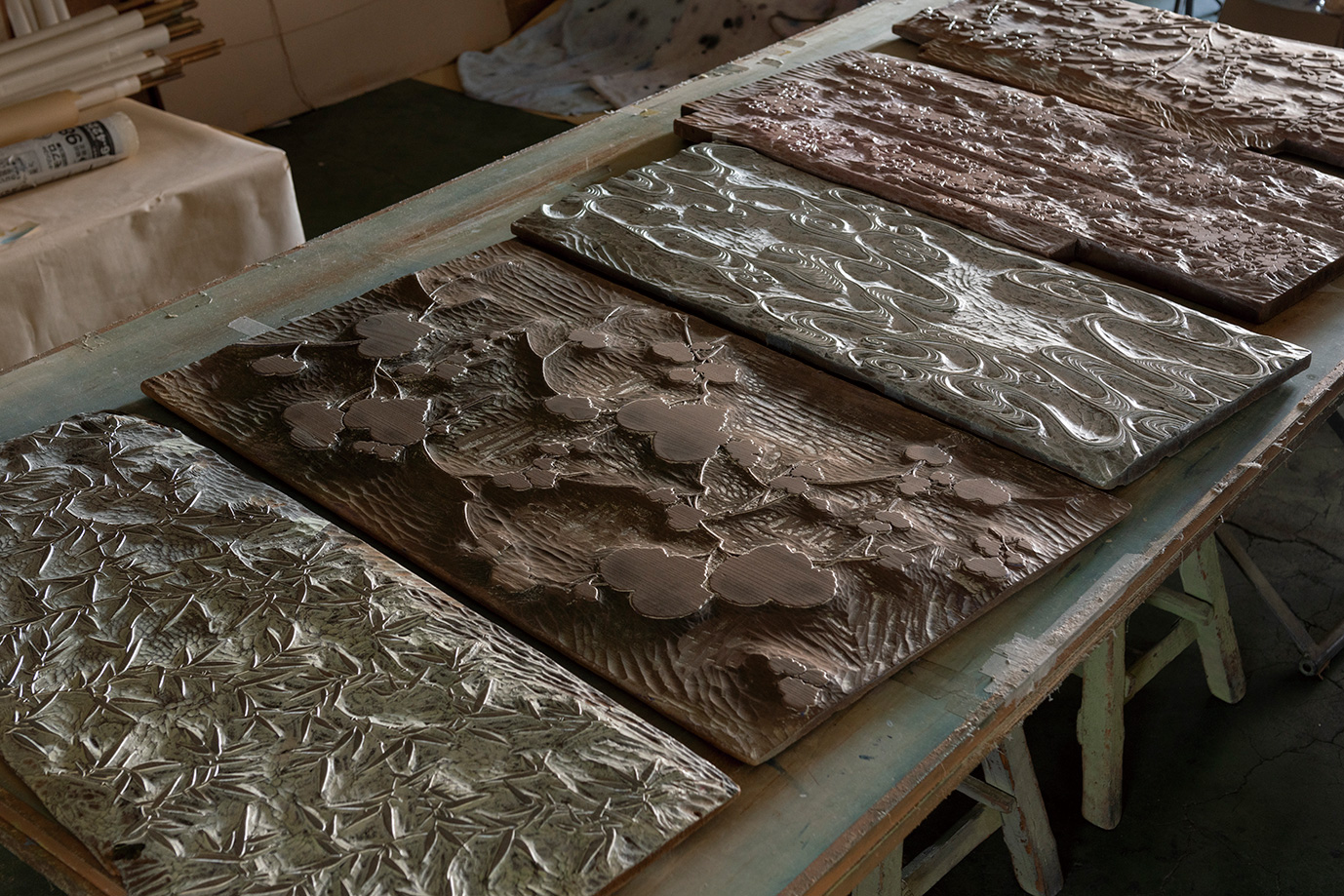
The production of large-sized paper (approximately 90cm x 180cm) led to the use of woodblocks larger than 90cm for making karakami paper in the Tokyo area.
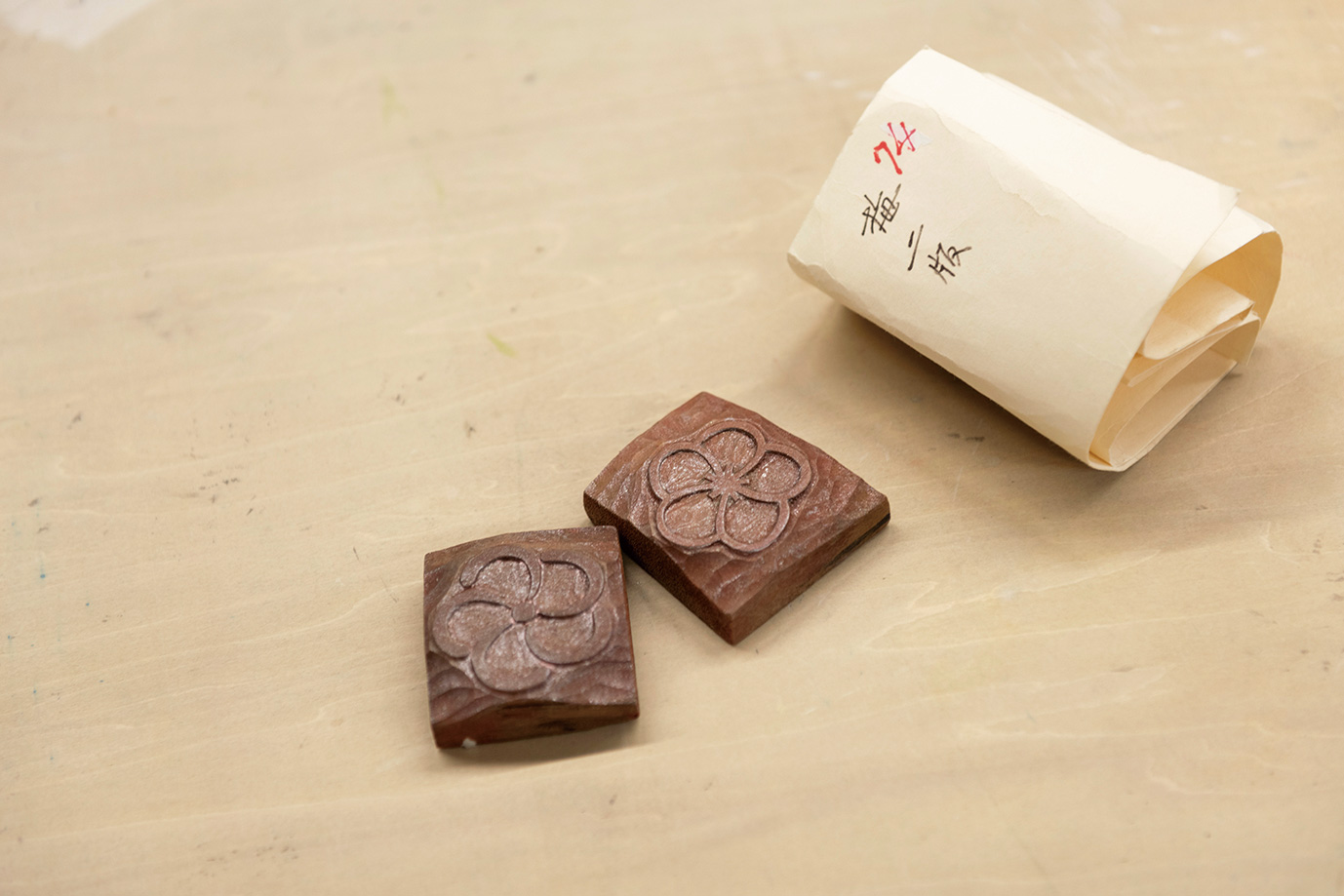
Small-sized woodblocks known as kiri-mochi (literally “cut rice cakes”). They can be arranged in various combinations to create diverse patterns.
Karakami (literally “Chinese paper”) is, true to its name, a kind of decorative paper that originates from a type of patterned paper brought from China. It boasts an ancient history. Domestic production of karakami started back in the Heian period (794–1185), when it gained popularity among the aristocracy and was used as ryoshi*2 for copying sutras and writing poetry and as an interior decoration material in temples and residences built in the palatial style typical for that period. During the Edo period, karakami widely permeated the lifestyle of the warrior class, townspeople, and commoners, and came to be used as decorative paper for fusuma sliding doors and wallpaper not only in the residences of feudal lords, Shinto shrines and Buddhist temples, but also in the homes of townspeople.
“I started creating karakami when I was around 20, but during the post-war period of rapid economic growth, cheap mass-produced printed paper took over the market and demand for hand-made fusuma paper gradually declined. Despite this trend, there was a growing momentum to revive production of authentic karakami paper, and once it was designated as a national traditional craftwork, the opportunities to work on restoration and repair of cultural assets using craftwork karakami techniques increased.” Yukio Koizumi has so far participated in projects to restore and repair the Pine Teahouse in Hama-rikyu Gardens, the Dutch Trading Post on the island of Dejima in Nagasaki, the Unryuzan Shoko-ji Temple in Toyama Prefecture, and other buildings designated as Important Cultural Properties.
As a karakami craftsman, in these projects he created the decorative paper used as overlay of fusuma sliding doors and walls, ceilings and folding screens. In recognition of his achievements, he has been recognized as Traditional Craftsman by the national government and the Tokyo Metropolitan Government. After receiving the title “Tokyo Meister” (an excellence award granted by the Tokyo Metropolitan Government), in 2019 the government of Japan awarded Yukio Koizumi The Order of the Rising Sun, Gold and Silver Rays.
There are several traditional decoration techniques for making Edo karakami paper. In the hangi-oshi (woodblock pressing) technique, patterns engraved on woodblocks are imprinted on washi paper by pressing the paper against the woodblock with smoothing motions using the palm of the hand. In the sarasa stencil technique, the paper is dyed using an Ise katagami stencil made of washi paper that is treated with persimmon tannin and then is engraved with patterns using a carving knife. In the sunago technique, gold or silver foil and metallic powder sunago (literally “sand”) made by cutting foil into small pieces are sprinkled over the surface of the paper to form decorative patterns. At Yukio Koizumi’s Karagen, diverse techniques are selectively used to create karakami paper with unique texture and feel. He demonstrated for us the hangi-oshi process.
The process of making karakami by woodblock printing
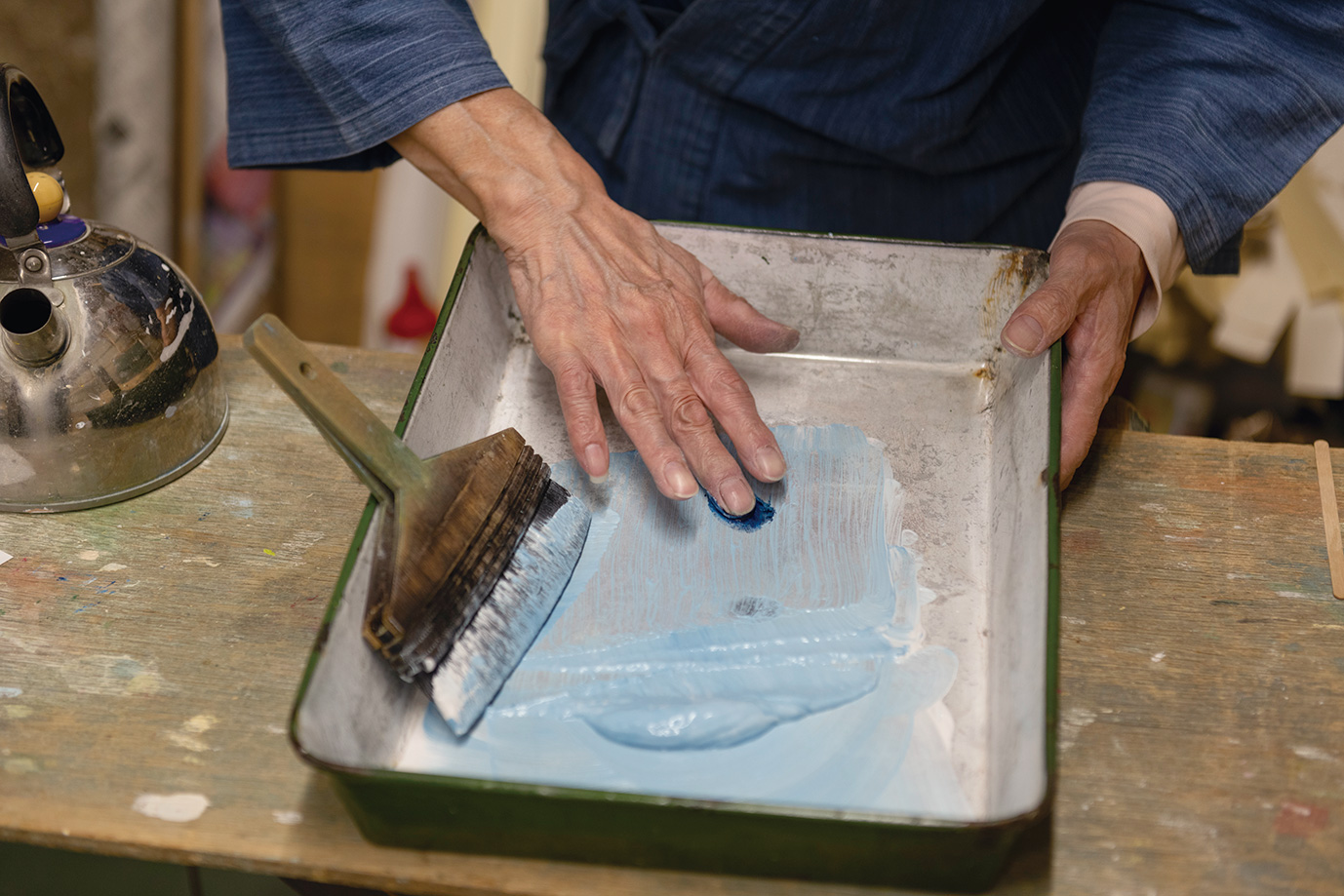
01
Funori (a seaweed-based paste), which will play the role of an adhesive, is melted by cooking, and then is mixed, using fingers, with mica, gofun, and pigments to make a paint.
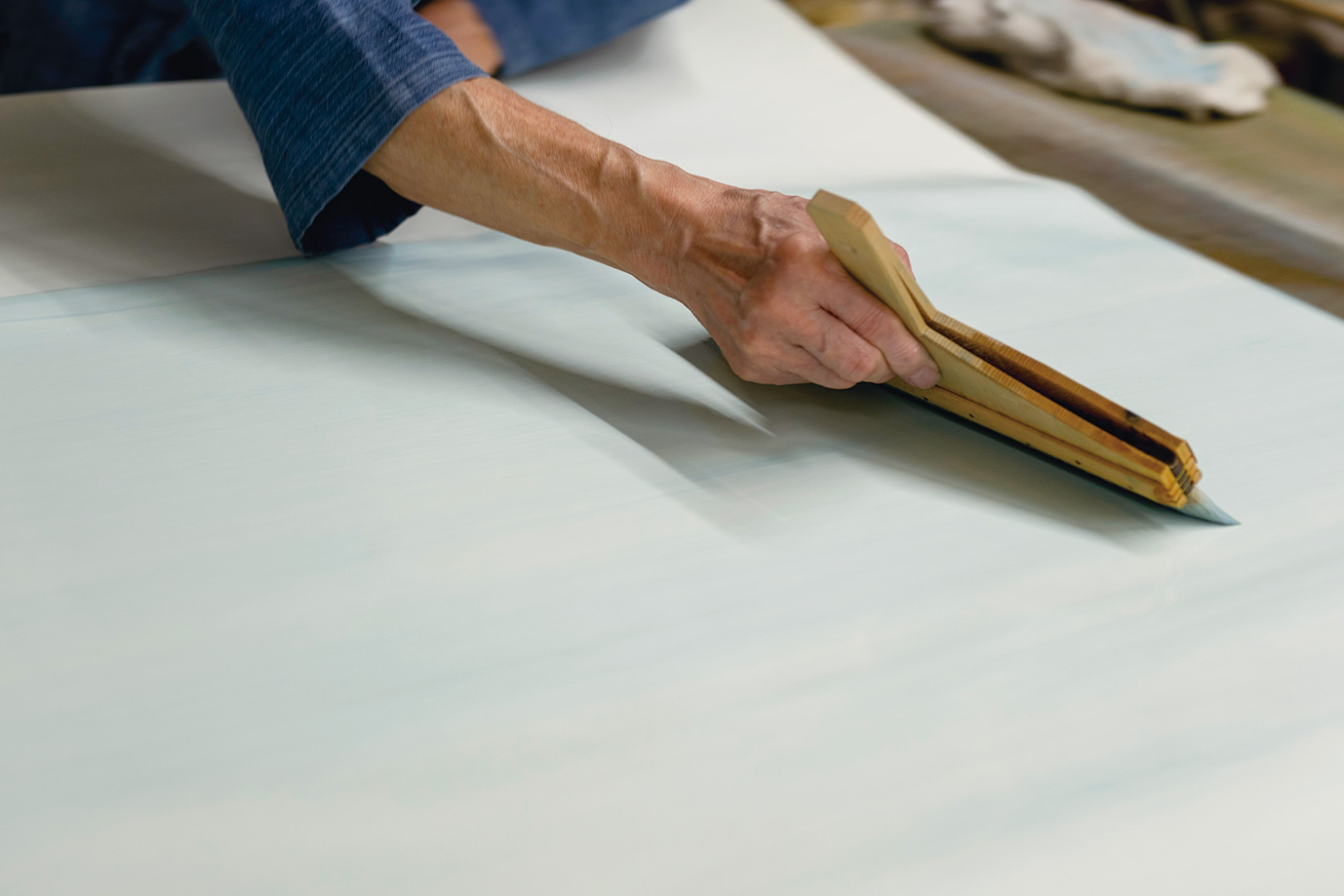
02
Next, a process known as gubiki is performed, in which light-colored undercoat is applied to the washi paper using a flat brush. After the first layer of undercoat is applied, the washi paper is dried, and then one more layer is applied to make sure that there are no patches and unevenness in the color.
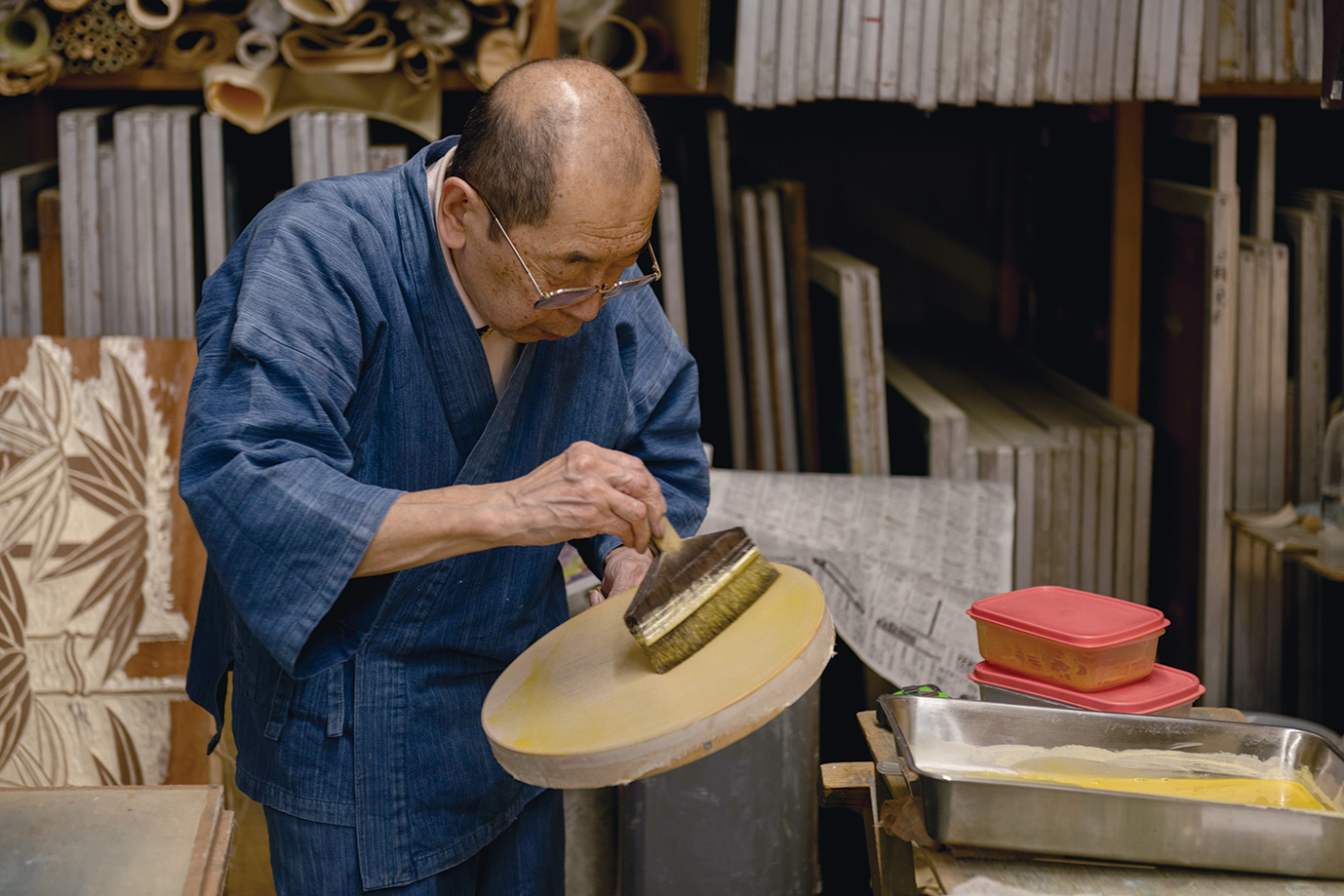
03
A large sieve is prepared by attaching a cloth to a round wooden frame, and the paint mixed with mortar is placed evenly into the sieve using a brush.
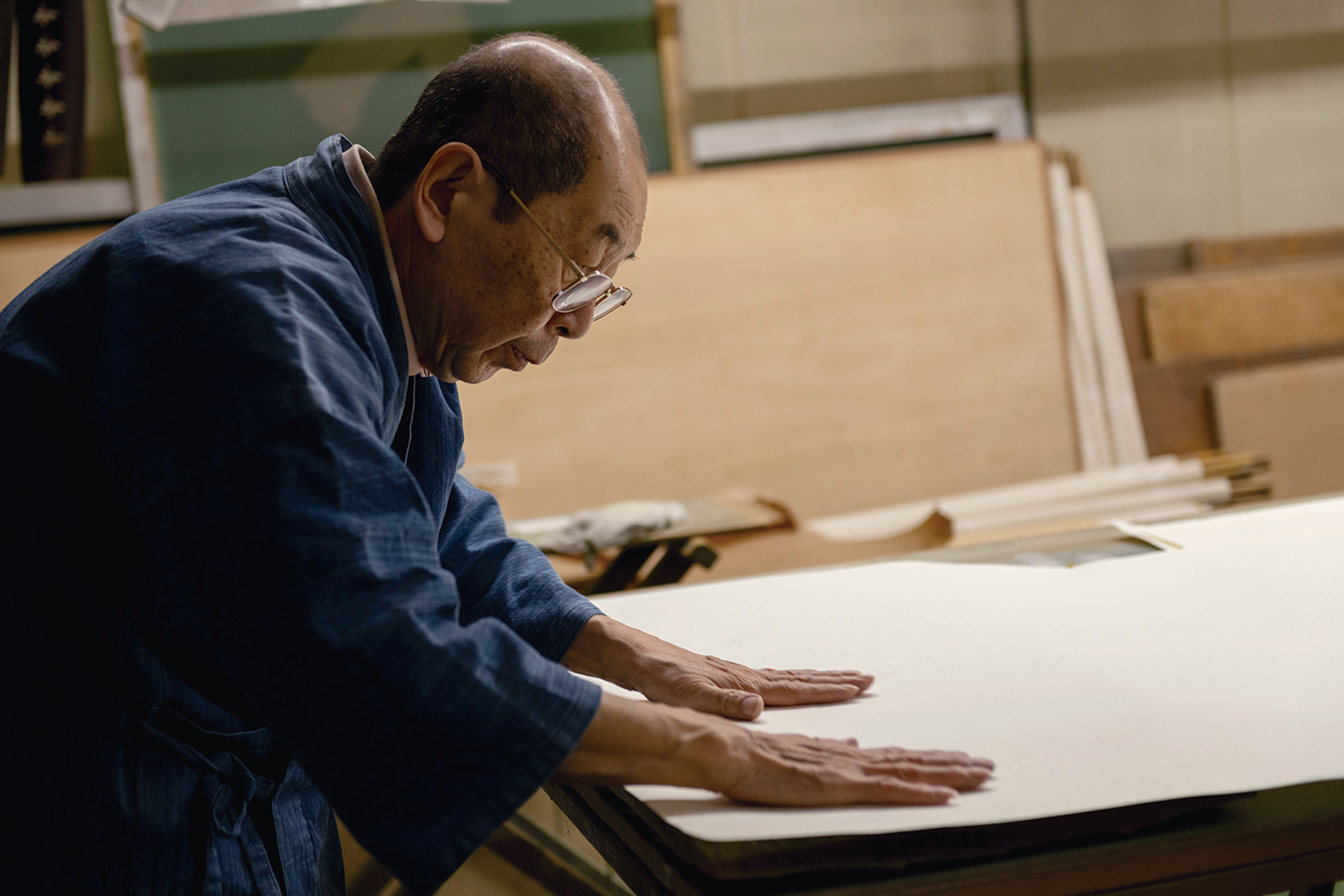
04
The paint is then applied over the woodblock by lightly pressing the sieve against it. The use of a sieve makes it possible to transfer the paint evenly and in an efficient manner.
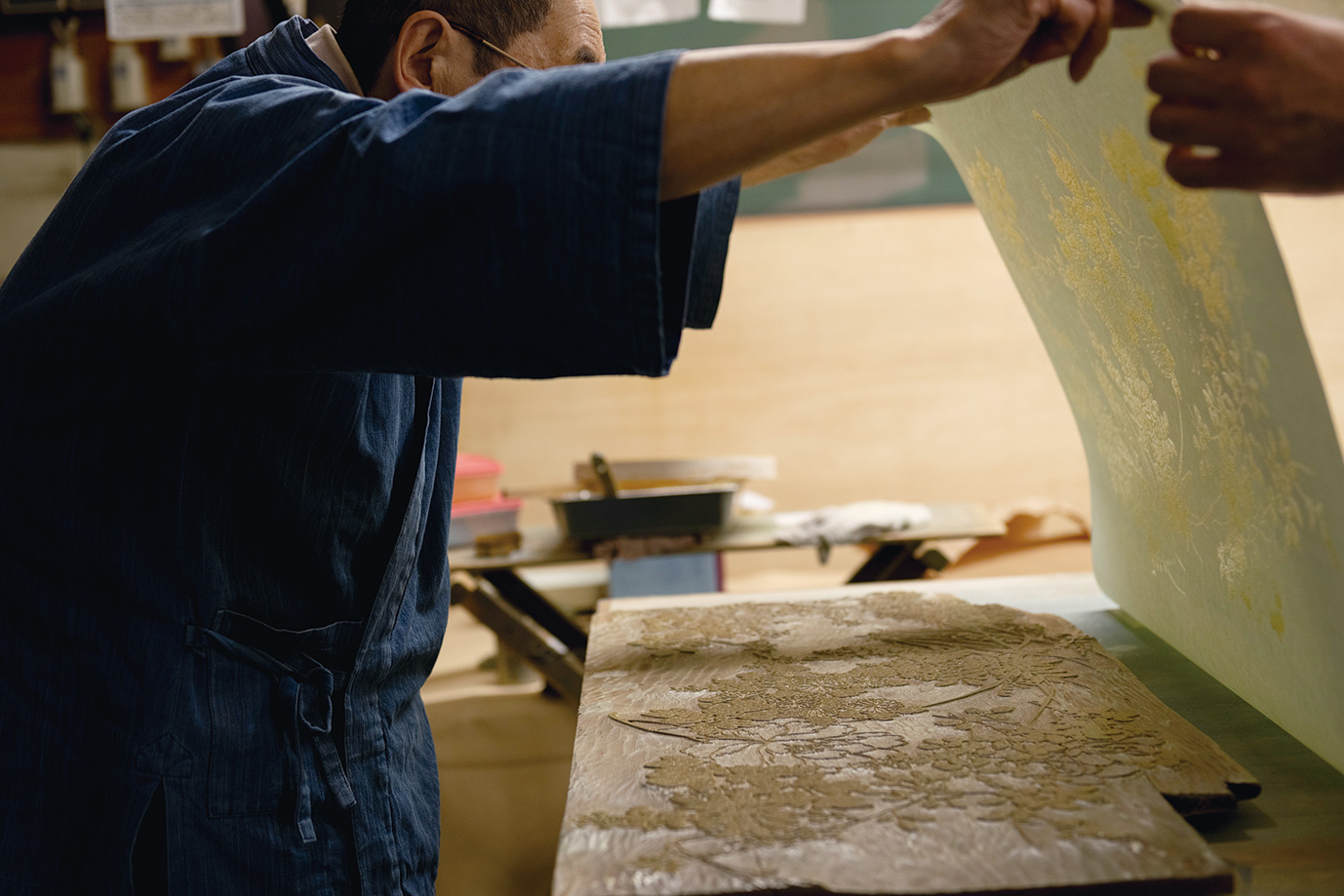
05
The washi paper is carefully placed over the woodblock making sure to maintain the right orientation, and pressed against the woodblock with smoothing motions of the palm to transfer the engraved patterns to the washi.

06
The process is repeated five or six times by moving the paper over the woodblock so that the imprinted patterns are connected. In the case of double printing, the process is repeated 10 or 12 times per fusuma.
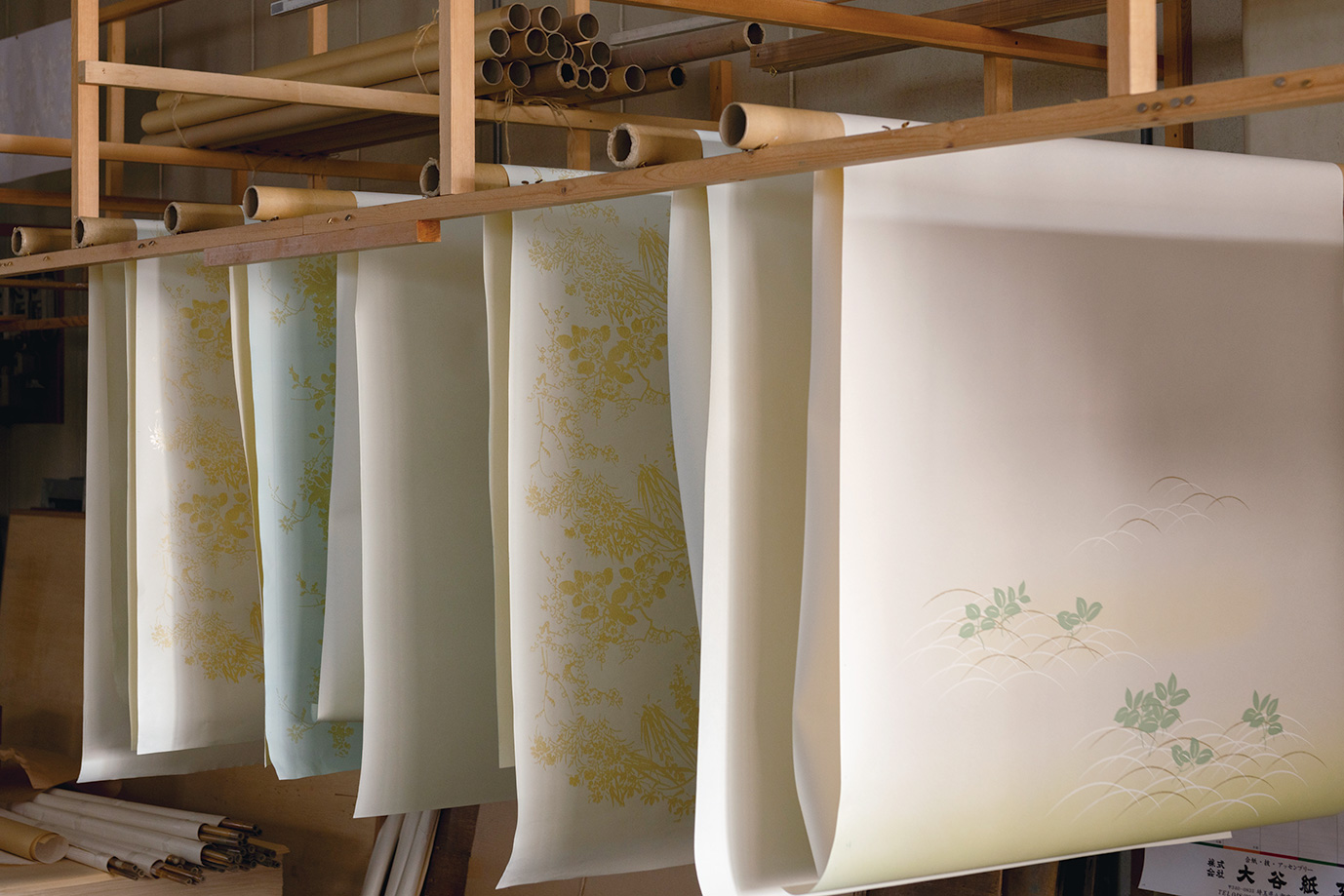
07
After confirming the finish of the imprinted patterns over the entire sheet, the paper is left to dry naturally. The atelier is lined with beautiful karakami papers imprinted with various multicolored patterns awaiting shipment.
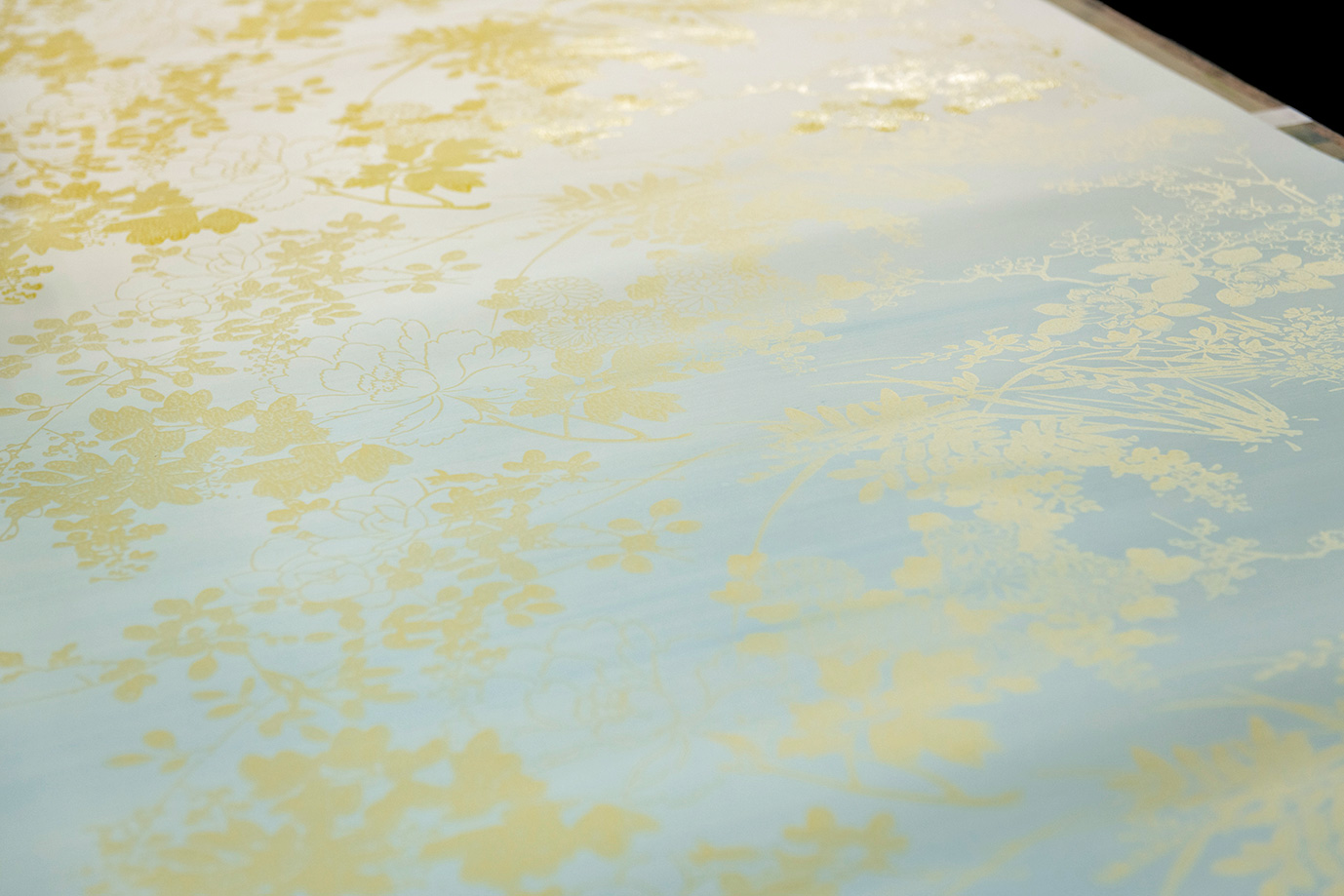
08
Through this process, the craftsman creates a single fusuma paper sheet that combines universal refined designs with the warmth of washi paper to achieve a sophisticated ambience.
According to Yukio Koizumi, the most difficult part of making karakami is the preparation of the paints. Color is added to gofun (a type of white granular pigment made from ground seashells), which is then mixed in water with the adhesive funori (a seaweed-based paste) or konjac potato paste, and the density and coloration are adjusted taking into account the temperature and humidity on that particular day. Light-colored undercoat is applied on to washi paper using a flat brush in a process known as gubiki, and then the prepared paint is applied through a special sieve over the entire surface of the woodblock. The washi paper is placed over the woodblock and pressed gently with smoothing motions using the palm of the hand to transfer the colors. The process is repeated by moving the paper over the woodblock, which is kept in a fixed position, creating beautiful karakami in which the connecting parts of the patterns match perfectly.
According to Yukio Koizumi, the most difficult part of making karakami is the preparation of the paints. Color is added to gofun (a type of white granular pigment made from ground seashells), which is then mixed in water with the adhesive funori (a seaweed-based paste) or konjac potato paste, and the density and coloration are adjusted taking into account the temperature and humidity on that particular day. Light-colored undercoat is applied on to washi paper using a flat brush in a process known as gubiki, and then the prepared paint is applied through a special sieve over the entire surface of the woodblock. The washi paper is placed over the woodblock and pressed gently with smoothing motions using the palm of the hand to transfer the colors. The process is repeated by moving the paper over the woodblock, which is kept in a fixed position, creating beautiful karakami in which the connecting parts of the patterns match perfectly.
The paper used in this technique is a high-quality, thick washi with smooth glossy surface known as torinoko-gami. Strong and highly-durable, this paper enhances the beauty of colors, and these qualities have made it the material of choice for book binding and mounting of paintings since ancient times. “We use a lot of Echizen torinoko-gami, but in many cases we work with paper provided by the customers, and most of our jobs are requests to imprint certain patterns on paper brought in by a customer, so in a way we are perhaps quite fastidious about being unfastidious. Our job as karakami paper craftsmen is also to come up with ways to give the most beautiful finish to each type of paper brought to us.”
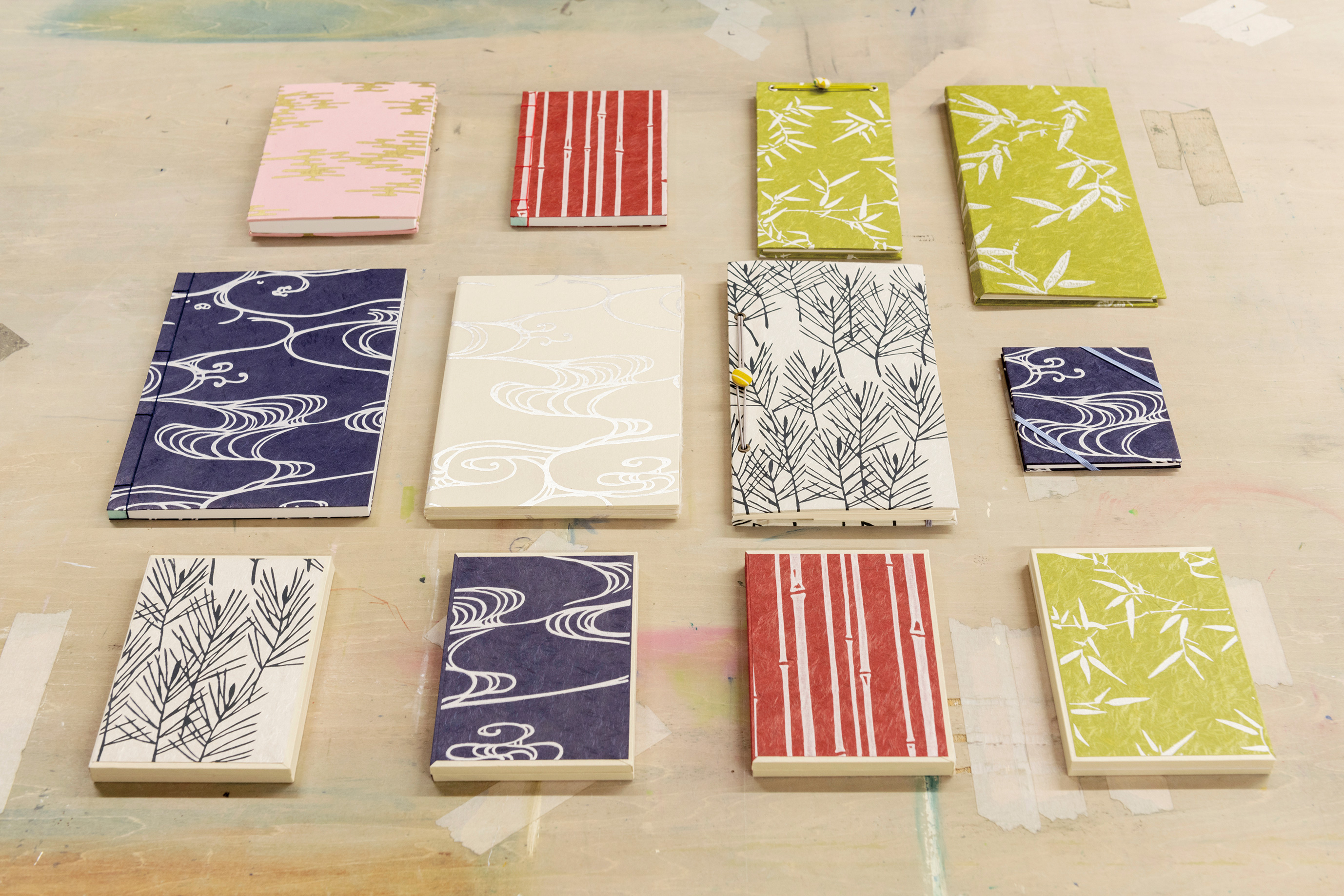
Various stationery items and everyday goods featuring karakami designs, such as Japanese-style bound notebooks, seal stamp notebooks, small notepads, and bookmarks.
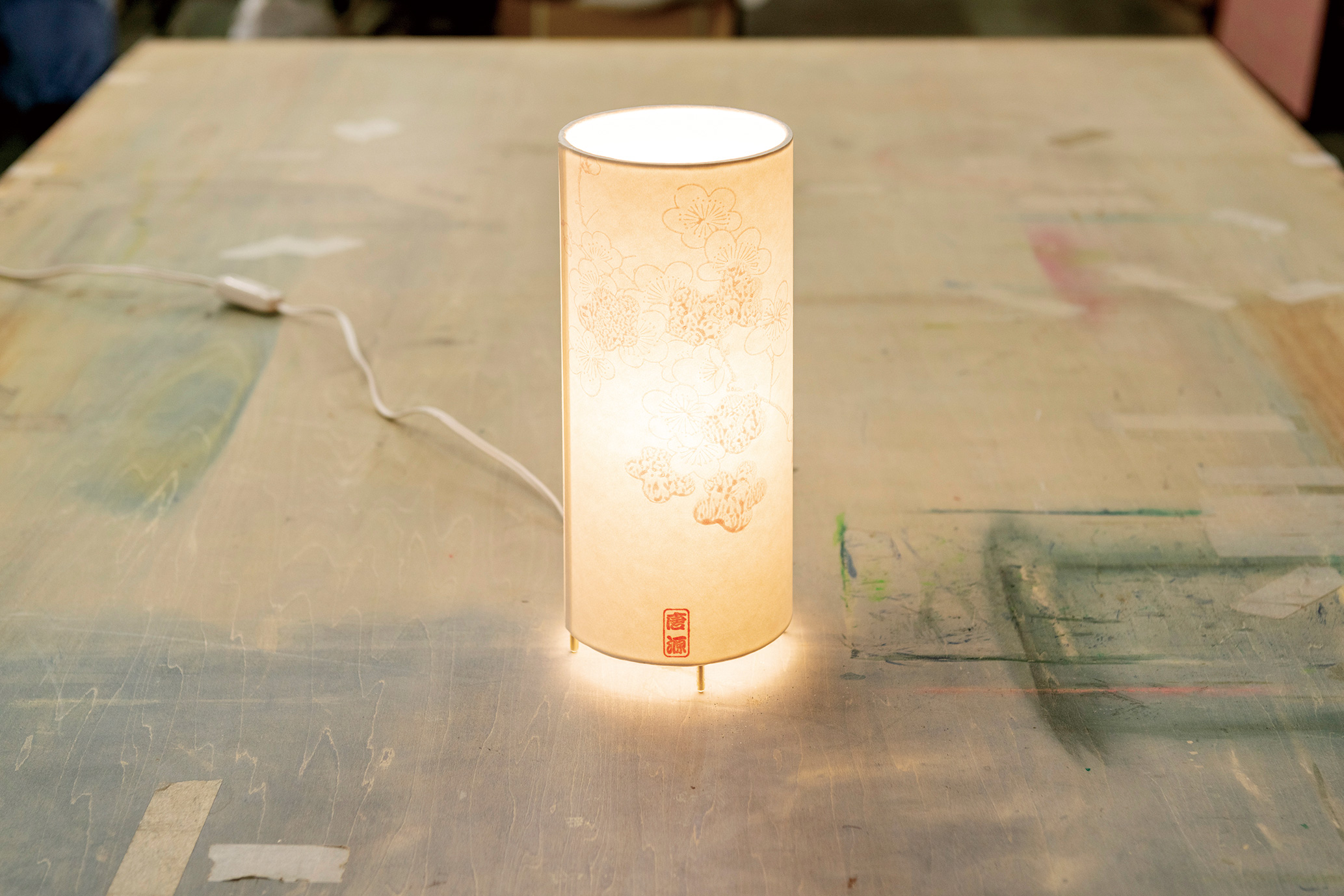
A lampshade that uses karakami patterns to produce a light and shade effect.
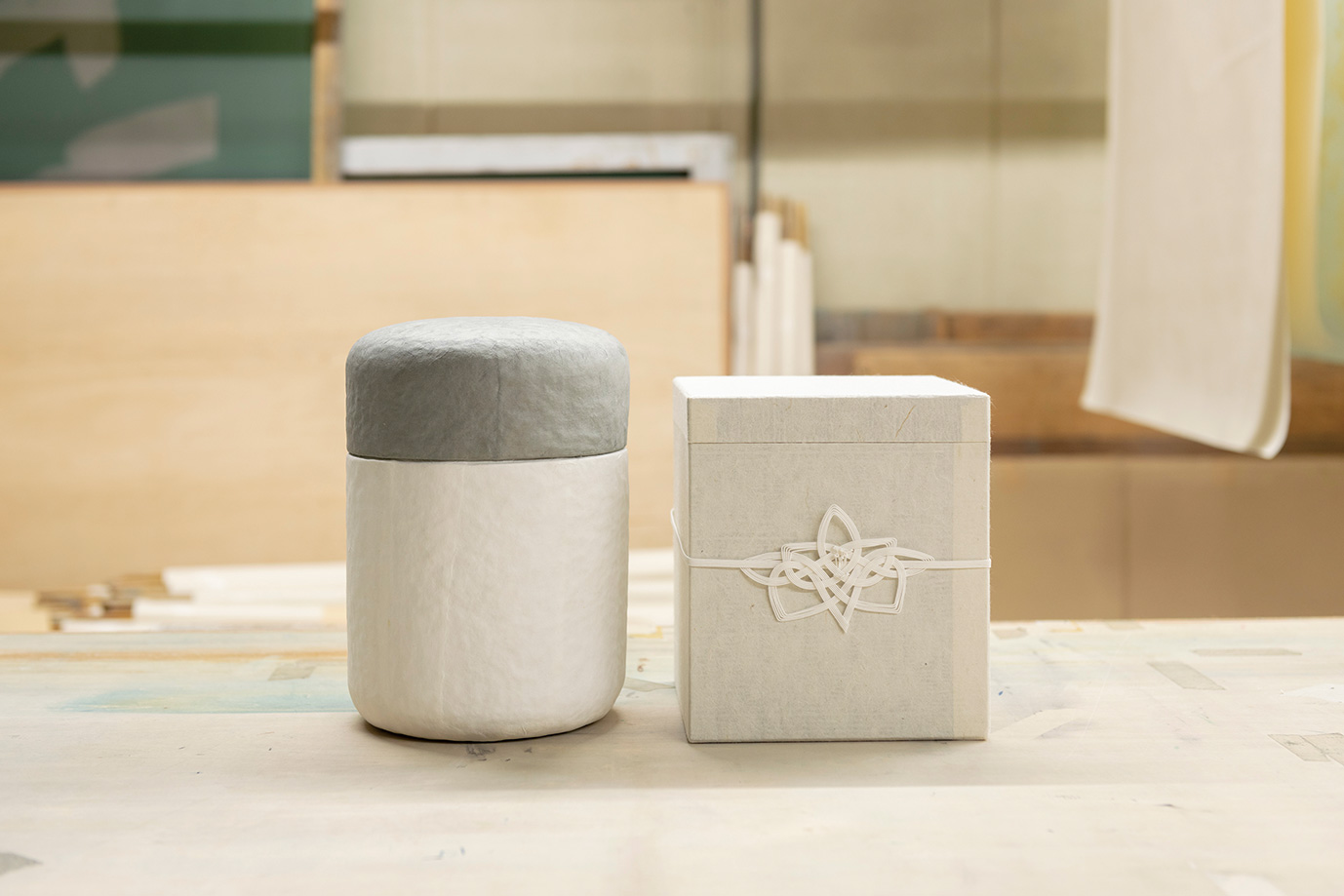
A prototype of a cinerary urn created using only natural materials. Its development is financed through crowdfunding. The company is also advancing projects for development of products such as roll-screens made of washi paper, etc.
In the past, every town in Japan had a workshop that made fusuma and shoji (light sliding doors), but as the lifestyle formats kept changing, the manufacturers of karakami paper have been going out of business one after the other. Today, Karagen appears to be the only workshop in the Tokyo area that makes karakami. Led by its president, Masayuki Koizumi, Karagen explores various approaches from new perspectives in order to keep alive this traditional craftsmanship that dates back to the Edo period. “Our goal is to apply
traditional techniques and create new products tailored to the changing times. I believe that by working in tandem with professionals from various industries, we still have ample opportunities to create combinations with new materials and come up with innovative means of expression,” says Masayuki Koizumi. The karakami products of his company made by infusing novel ideas into traditional techniques born in the Edo period boast new added value and enjoy an ever-expanding field of applications, from stationery for everyday use to interior items with sophisticated design qualities.
Karagen Inc.
Address: 1255-3 Osone, Yashio City, Saitama
Tel: +81-48-934-9438
HP:https://www.koizumihusumagami.com/
Original products made by Karagen can also be purchased through the following online retail website.
